Workplace Improvements in Small Businesses
through Ergonomic Intervention
By Isao Koide
Toyota Motor Corporation
1. What is Ergonomics?
* A lack of concern to incorporate ergonomic concepts in the workplace may lead to increased risk of occupational accidents and occupational diseases.
While research and state-of-the-art technology are matters of high interest to businesses, practical efforts to improve the workplaces where workers actually spend time are often neglected. Incorporating ergonomic concepts is an easy solution for improving working conditions and productivity.
The following definition of ergonomics is one stated by many scholars including C. C. Wood, W. E. Woodson, W. F. Floyd, and A. Chapanis. Summarizing, it regards the relationship between engineering and human science from a common viewpoint, whereas the two fields were formerly considered on completely independent terms.
"Ergonomics searches for the conformity ( harmony) between humans and machines (work)."
2. The Relationship between Ergonomics and Business
* Ensuring the safety for workers and maintaining or improving productivity are two of the major concerns facing businesses today, owing to the diversified systems for production and an aging society.
Thus it is necessary to establish a workplace for workers that is safe and comfortable, by incorporating ergonomic concepts based on "Striving for conformity between workers and machines (work)".
The elements of ergonomics which may be applied to production workplaces include the following:
(1) Work space (work posture)
(2) Operated machines (hand tools)
(3) Work procedure (movements and working time)
(4) Information display (instrument panel, signals)
(5) Environmental factors (illuminance, coloring)
(6) Labor system (form of duty, shifts)
(7) Load on the worker (physical, mental)
This report focuses on measures for reducing the physical load experienced by workers, as in items (1), (2), (3), and (7) above, and introduces representative case examples which were actually implemented in the company.
3. Measures to Reduce Work Load
*A common example of ergonomics is a measure to reduce work load by normalizing the onset of muscular action. This is done by incorporating characteristics of the human being into the design of machines and work facilities, so that large muscles are not exercised.
In order to reduce work load, it is necessary to modify the work by evaluating the functions required of the work together with the characteristics of humans on a common scale.
In other words, the work movements must be analyzed, and the human functions most frequently used in the work must be determined and expressed numerically. In cases where the work load exceeds a certain standard, fundamental measures are required for improvement. These include making slight but effective changes in the manufacturing workplace, improving the work method, making design modifications in the parts, or remodeling the production facility.(Fig. 1)

4. Using the Ergonomic Checklist
* In applying ergonomics to production workplaces, it is necessary to tailor the solutions to the respective workplaces in question.
It is important to grasp the nature and location of existing problems based on the state of production, occupational accidents, and complaints from workers. Then, these problems can be compared with ergonomic standards (the various evaluation methods) to determine their severity, and an effective improvement measure should be contrived where necessary.
As an example, Table 1 shows a work checklist for handling heavy loads, a cause for the typical occupational disease of low back pains commonly experienced in production workplaces.
Table 1 Work Checklist for Handling Heavy Loads 
5. Method for Evaluation of Work Load
* In recent years, the form of labor in the automobile industry has shifted from one of physical labor involving the entire body, to work using limited muscles, visual work, and work with high mental stress. Thus it has become necessary to evaluate the human in terms of separate functions. In 1982, Toyota developed and implemented a system using element classifications and evaluation items (Table 2) which conform to actual operation practices, based on the "GULHEMP" system developed in Canada in 1972.
In recent years, Toyota has made further advances in developing and applying automation systems to reduce the worker load in vehicle assembly lines which rely heavily on human labor, and in establishing a quantitative table (TVAL) for evaluating work load in the facility.
Table 2 The Toyota Method Function Evaluation System (GULHEMP)
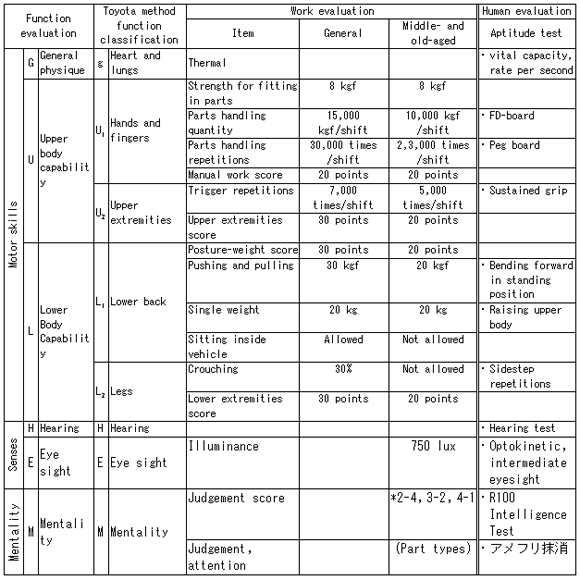
6. Work Load Indexes and Points for Improvement
6-1 Work Posture and Manual Work Posture
(1) Basis of evaluation
* In evaluating the postures in these two classifications, the percentage of maximum voluntary contraction (%MVC) values were measured for specific muscle groups using an electromyograph, and the total of the individual values in the group was used to represent the numerical value of the load for that posture. The muscle group measured for work posture evaluation consisted of the four main muscles of the hip region (back muscles and abdominal muscles), and for manual work posture evaluation, the four main muscles of the upper extremities(forearm flexor muscles, biceps brachii, deltoid muscle, and trapezius). The postures having a high load value were subjected to improvement measures (Fig. 2, 3).
(2) Points for good working posture
| i) |
Do not bend over (minimize the bending angle of the back). |
| ii) |
Keep the knees straight (avoid bending the knee joints). |
| iii) |
Avoid twisted postures. |
| iv) |
Height of the working level should be between the shoulders and navel of the worker. |
| v) |
Work objects should be located within an appropriate working area (within a circular area centering around the elbow joint). |
| vi) |
Work objects should be located within an appropriate field of vision (within: right eye 30 degree, left eye 30 degree, total 60degree) |
(3) Effects of Good Posture
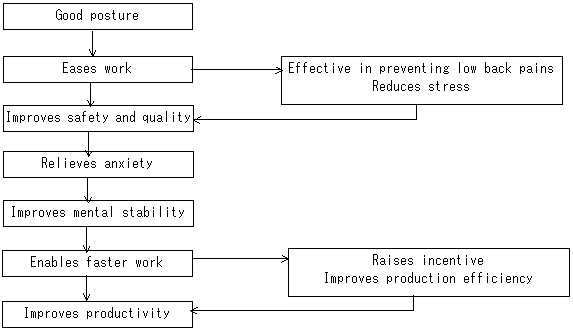
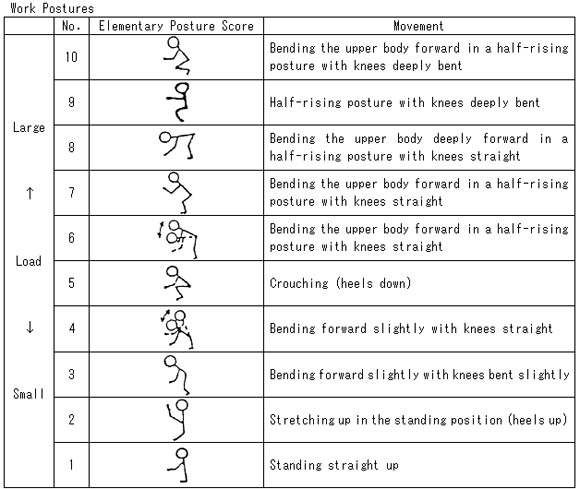
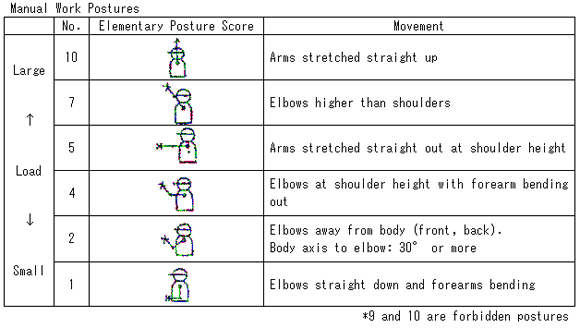
6-2 Index for Load on Lower Back (Posture-weight Score)
(1) Basis of Evaluation
* Loads on the lower back are mainly caused by bad work posture and heavy loads, as described in 6-1 earlier.
The following index was developed using weight of a single load and holding time as the bases.
Posture-weight score = (Posture score) + (2 x Weight score)
Posture score =Σ[ Elementary posture score x Time (h/day)]
Weight score = Σ[Weight of a single load (kg) x Handling repetitions (h/day) x Travel coefficient/1000 [ x Time coefficient |
(2) Points for improvement
Steps and worker stands are effective in bringing the worker closer to his point of work to improve the posture score, while measures for the weight score include reducing the load, applying suspending devices, and shortening the transport distance.
6-3 Index for Load on Upper Extremities (Upper Extremities Score)
(1) Basis of Evaluation
* Loads on the upper extremities are mainly caused by strain from manual work postures and from holding hand tools, as described in Section 6-1.
The holding strength values for when hand tools are being used or transported were taken from measurements using an electromyograph.
Upper extremities score = Manual work score + Holding strength score
Manual work score =Σ[Elementary manual work score x Holding time (h/day) ]
Holding strength score = Σ[ Operation strength score x Operating time (h/day) + Travel strength points x Travel time (h/day)] |
(2) Points for improvement
Installing worker stands to bring the point of work closer to the worker and shortening the holding time are effective measures for improving the manual work score, while reducing the weight, and reducing the necessary trigger repetitions may be applied for holding strength score improvement.
6-4 Index for Assembly Work Load (*TVAL)
(1) Basis of Evaluation
* Assembly work often involves use of the entire body, as opposed to the partial movements in the aforementioned lower back and upper extremities evaluations, thus the % MVC was measured in muscles all over the body (20 muscles). Moreover, the biological load was calculated taking into account the fact that muscular strain increases with continued constant movement.
L = 25.5 log(t) + 117.6 log(WB) - 162.0
L -- Biological load (TVAL)
t -- Continuous working time
WB -- Pedal load |
*TVAL -- Toyota Verification of Assembly Line
(2) Points for improvement
(i) Work posture (work moved from indoors to outdoors, change in height of body)
(ii) Reducing the force required for assembly (pushing, fixing in, pulling)
(iii) Weight support for the parts (reducing the weight)
7. Main Examples of Improvement
(1) Measure to Improve Posture-weight Score (Work Posture)
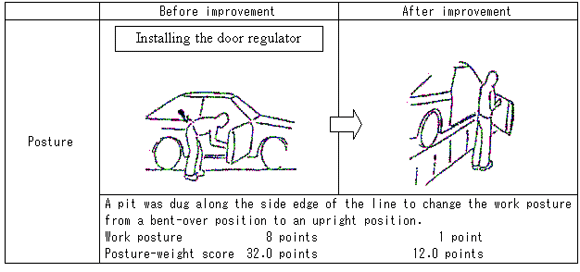
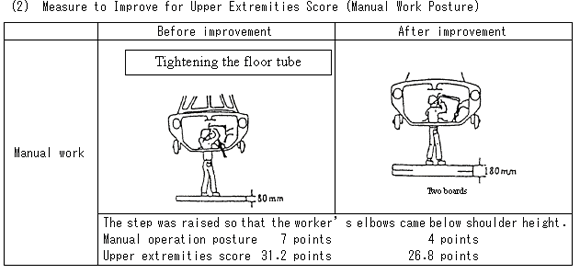
8. Conclusion
* Although applying ergonomics to the production workplace may sound complicated, it is actually equivalent to what we do in everyday life. For example, if we feel tired from working bent over, we change posture or change tools. If written characters are difficult to read, we adjust the lighting or character size. If a distance is too long and tiring to walk, we install a shoot on the work table.
Therefore, it can be said that relieving the discomforts experienced by humans is in fact the essence of ergonomics.
Practicing ergonomics in the production workplace thus involves the striving for harmony between humans and work by small contrivance ideas.
|







